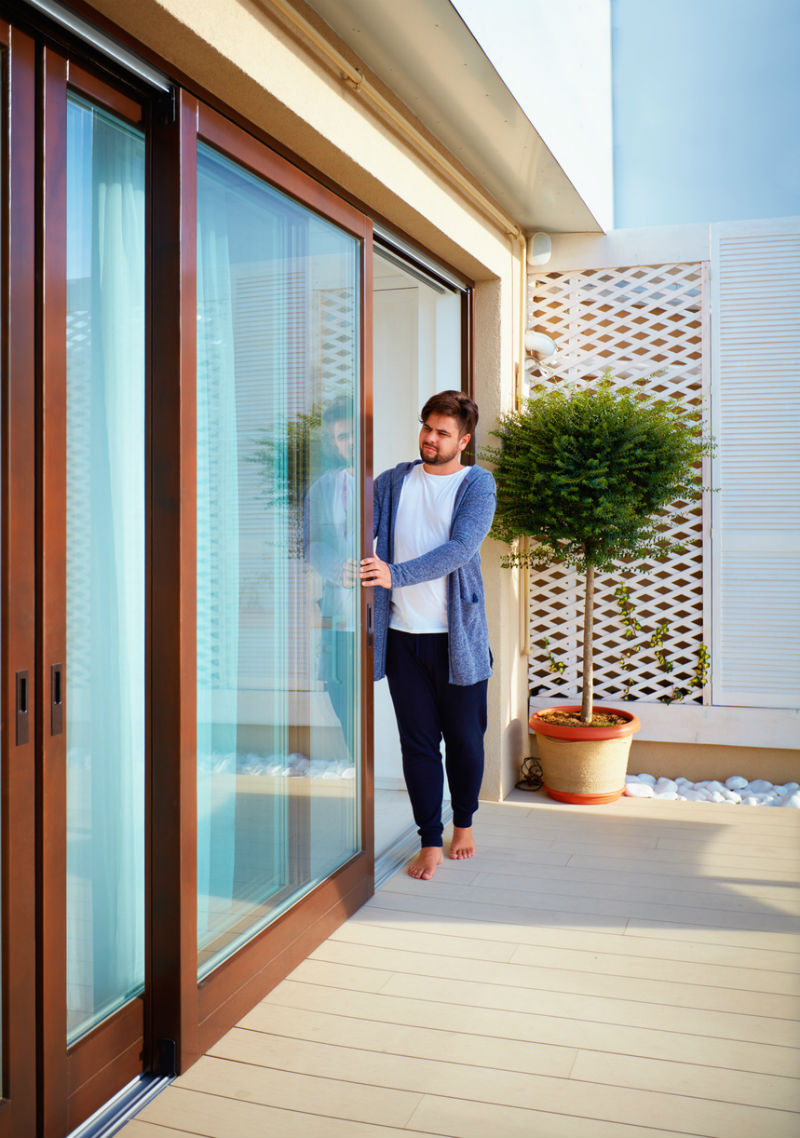We may earn revenue from the products available on this page and participate in affiliate programs. Learn More ›
If you have a glass sliding door in your home, you no doubt appreciate how it creates a nearly seamless visual connection between the indoors and outside, lets natural light stream into the room, and makes a small space seem larger. But a glass sliding door simply isn’t as secure as a traditional wood, metal, or fiberglass door. Glass, after all, is easily broken, and a thief who’d rather not make a ruckus by smashing the pane could probably make short work of the vulnerable lock sliding doors tend to have.
RELATED: 10 Free and Low-Cost Ways to Improve Your Home Security
Fortunately, to beef up home security, there are easy steps you can take to make glass sliding doors more defensive. The following three measures don’t cost much money or take a lot of time to implement, so for the best results, use all three.

1. Block the tracks.
Sliding doors open and close by moving horizontally along upper and lower tracks. So one of the simplest ways to increase sliding door security is to put an obstacle in the track to prevent motion. With the blocker in place, a would-be burglar can’t slide the door open from outside. A blocker would also act as an impediment to a curious toddler or an elderly family member suffering from confusion and prone to wandering—both scenarios of concern to many families.
You can make a door blocker by cutting a wooden broom handle or dowel of similar thickness down to a size that fills the bottom track when the door is closed. If you don’t care to DIY, commercial solutions are available. Most are simple metal dowels that adjust in length to work with the majority of sliding doors, generally around 25 to 45 inches. You can even find decorative door blockers, such as the U.S. Patrol Sliding Door Lock Bar available on Amazon, to add an attractive element of scrollwork along with extra security.
2. Lock it tight.
While your front door likely has a deadbolt along with a locking knob, the sliding glass door to your backyard or patio probably has just a simple latch clamped onto the doorframe to stop the door from sliding. Unfortunately, that latch isn’t much of a deterrent to a determined burglar, who can pry it open with a screwdriver.

To ramp up sliding door security, back up the latch with a steel secondary locking system. Of the various configurations of such devices, a common loop lock is inexpensive and effective. A loop lock has a metal casing on each end—one end attaches to the sliding portion of the door, the other to the doorjamb—and a steel pin that drops down into the casings to lock the door and lifts up to unlock it.
To install, drill screw holes into both the doorjamb and the sliding frame of the door, and then screw the loop lock into place. Loop locks sell at home improvement centers for less than $10 (see the offerings at Home Depot) and putting one in is a basic, 15-minute DIY job. The peace of mind return on investment will be priceless.
RELATED: The 25 Smartest and Smallest DIYs You Can Do for Your Home
3. Reinforce the glass.
Your sliding door’s large expanse of glass lets would-be burglars peek in to determine who—and what—is inside. It’s then merely a matter of striking the door with a rock or brick to shatter the glass, reaching inside, undoing the latch, and sliding the door open.
Applying security film to the insides of the glass can give the sliding door extra strength. These extremely thin vinyl films add a layer of strong support, making it very difficult to break through the glass. This helps keep out burglars and also adds extra protection against high-wind events or kids get carried away playing ball.
There are clear security films, mirrored films, and films opaque enough to prevent anyone from seeing inside yet still translucent enough to admit some light. The last option is most secure, but few homeowners want to give up unhampered outdoor views. Also, be aware that mirrored films reflect only on the side that is currently the most brightly lit, meaning that during the day, when it is generally brighter outdoors than inside, a person outside your home will see their own reflection in the door, while you will be able to look right through the glass from the inside. At night, when you have the lights on inside the house, the opposite will be true; it’s you that will see your own reflection in the sliding door, while a person in the yard will be able to look right through the glass.
You can buy rolls of security film at home improvement centers for between $10 and $30 per roll, depending on the type, brand, and size—enough to cover the average sliding door. Though not difficult, successfully applying security film to a sliding door is tedious and generally requires an assistant.
- Measure the width and height of both panes of glass in your sliding door. You’ll need a roll of film wide and long enough to cover both panes of glass in your sliding door. Glass films are sold in a wide range of sizes, so choose the size that best matches your door’s measurements.
- Clean the glass thoroughly. Any dust, lint, or fingerprints on the surface of the glass will be caught beneath the security film. Fill a one-quart mister bottle with distilled water (it won’t leave white mineral deposits once it dries) and add one-quarter teaspoon of baby shampoo or mild liquid dish soap. Shake well, spray the glass, and wipe clean with a lint-free paper towel, coffee filters, or crumpled newspaper. Don’t forget the corners, where grunge tends to accumulate.
- Roll out the security film on a large, flat, clean surface. Use a pencil to mark your door’s measurements, minus one-eighth of an inch all the way around. This gap will allow you to squeegee away air bubbles and water later. Carefully cut your film to size using sharp scissors or a utility knife.
- Spray the glass with your soapy water mixture until water runs down the door. The water helps hold the film against the glass during installation and gives you a bit of “slip” so you can reposition the film if necessary before adhering it into place.
- Lift the film up in front of the glass pane and begin to peel. With your assistant, take care not to crease or wrinkle the film—you’ll probably need a stepstool to reach the upper edges of the door. Peel away the film’s liner from the top inch of the material, and then fit the film against the upper edge of the glass, starting in one corner and carefully lining up the film with the upper edge of the door.
- Peel and press it into place. As your assistant holds the top of the film in place, slowly peel away the rest of the liner, pressing the film against the glass as you go.
- Make any needed adjustments to the film’s position. Then smooth the film into place with your hands, working from the middle out towards the edges of the glass.
- Squeegee any trapped air bubbles and excess water out from underneath the film. Start at the top and work your way down, smoothing the squeegee from the center of the film towards the outer edges. Continue until the film completely adheres to the glass and there are no visible air bubbles or water caught between the glass and the film.
- Trim away any excess or uneven film with a utility blade.
- Repeat the process on the other pane of the door.
- Dry with clean rags. Wipe the surface of the film as well as any puddled water on the floor.

